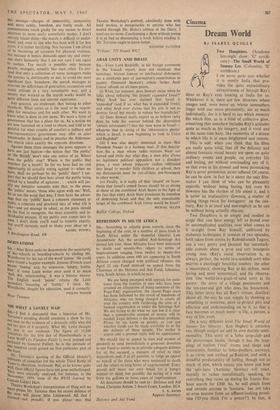Cinema
Dream World
By ISABEL QUIGLY Two Daughters. (Academy
I AM never quite sure whether
it is mostly India that pro- vides the quite extraordinary
attractiveness of Satyajit Ray's films or Ray's eyes looking at India for us. Whichever it is, there are few directors whose images and, even more so, whoSe atmosphere linger with one more persistently; not so much individually, for it is hard to say which memory fits which film, as in a kind of collective glow, something that somehow includes Ray's attitudes quite as much as his imagery, and is vivid and ai the same time hazy, like memories of a dream in which life is at once heightened and remote.
This is- odd, when you think that his films are really quite solid, that all the delicacy and almost fantastic visual beauty 'are spent on quite ordinary events and .people, on, everyday life and feeling, yet without overloading any of it, so that even at his slowest and most 'painstaking Ray is never portentous, never inflated. Of course, he can be slow, in fact he is about the only film- maker I can think of who can be pleasantly soporific without being boring, but even his slowness has the rhythm of life about it, and it is never an explanatory slowness, a matter of saying things twice for foreigners: on the con- trary, Ray is as local and non-explicit as he can be without being actually obscure.
Two Daughters is so simple and modest in scope that you have energy left to brood over its uncomplicated qualities, over what comes to it straight from Ray himself, unfiltered by elaborate techniques. It consists of two episodes, both taken from stories by Rabindranath Tagore, one a very pretty and pleasant but unremark- able comedy about a prim and very bourgeois young man (Ray's social observation is, as always, perfect, the world-in-a-nutshell sort) who marries a dazzlingly beautiful tomboy; the other a masterpiece, showing Ray at his deftest, most loving and most economical, and his observa- tion (the world-in-a-grain-of-sand sort) at its purest: the story of a village postmaster and the ten-year-old girl who does his housework. This latter story has all Ray's virtues, distilled; above all, the way he can, simply by showing us something or someone, seem to project pity and affection and understanding on to it, so that a face becomes so much more—a life, a person, a way of life, even.
On a very different level The Small World of Sammy Lee (director: Ken Hughes) is attractive too, though malgre soi and its own deathly senti- mentality. This story of a Soho strip-club and the picturesque locals, though it has the trap- pings of realism (`real' streets and shops and restaurants, familiar to Soho-dwellers, anyway), is as corny and stylised as Runyon, and with a dreadful predictability" of feeling, though not so much of plot, which means you know just how the spiv-hero (Anthony Newley) will react, morally or rather moralistically speaking, to everything that turns up during his frantic five- hour search for £300. So, he will pinch from and swindle anyone in 'business,' but not take or even borrow from an affluent-looking prosti- tute (`D'you think I'm a ponce?'). In fact, it is a soft-centred and foolish film, but made with some wit (verbal more than visual), and much bounce, and, within the limitations of its soft- centred foolishness, a hard, uncomfortable per- formance from Mr. Newley.







































 Previous page
Previous page